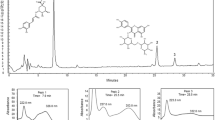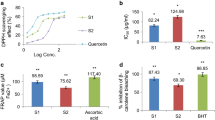Abstract
Garcinia pedunculata, a tropical plant found abundantly in the north-east region of India, has been used by many traditional healers for various gastrointestinal ailments. Studies are being carried out for the proper pharmacological identification of the compounds as well as the mode of action for the treatment of various diseases. In this study, phytochemistry of the fruit was evaluated, followed by a quantitative analysis of the total phenolic and flavonoid content of the methanolic crude extract as well as different fractions (n-hexane, chloroform, ethyl acetate, and n-butanol). The fraction with the most potent flavonoid and phenolic content was evaluated for its anti-inflammatory activity using both in vitro and in vivo assays. The chloroform fraction of G. pedunculata fruit extract was found to have a substantial amount of phenols and flavonoids. This fraction inhibited the denaturation of BSA and significantly stabilized human RBC membrane compared to the standard drug Diclofenac sodium. The fraction also significantly reduced the formaldehyde-induced paw edema in mice and normalized the blood parameters. This study provides evidence that G. pedunculata fruit extract plays a critical role in anti-inflammatory activity, indicating that it can be a potential candidate for further investigation in the treatment of inflammation-related diseases.







Similar content being viewed by others
Data availability
The datasets used and/or analysed during the current study are available from the corresponding author on reasonable request.
References
Ambriz-Pérez DL, Leyva-López N, Gutierrez-Grijalva EP, Heredia JB (2016) Phenolic compounds: natural alternative in inflammation treatment. A review. Cogent Food Agric 2:1131412
Anyasor GN, Okanlawon AA, Ogunbiyi B (2019) Evaluation of anti-inflammatory activity of Justicia secunda Vahl leaf extract using in vitro and in vivo inflammation models. Clin Phytoscience 5:1–13
Bhattacharjee S, Devi R (2021) A comprehensive review of Garcinia pedunculata Roxb. and its therapeutic potential. Mini Rev Med Chem 21:3113–3143. https://doi.org/10.2174/1389557521666210217094152
Bhattacharjee S, Elancheran R, Dutta K, et al (2022) Cardioprotective potential of the antioxidant-rich bioactive fraction of Garcinia pedunculata Roxb. ex Buch.-Ham. against isoproterenol-induced myocardial infarction in Wistar rats. Front Pharmacol 13:124-144
Biava MP, Norbiato G (2015) Getting an insight into the complexity of major chronic inflammatory and degenerative diseases: a potential new systemic approach to their treatment. Curr Pharm Biotechnol 16:793–803
Bratovcic A (2020) Antioxidant enzymes and their role in preventing cell damage. Acta Sci Nutr Heal 4:1–7
Candore G, Caruso C, Jirillo E et al (2010) Low grade inflammation as a common pathogenetic denominator in age-related diseases: novel drug targets for anti-ageing strategies and successful ageing achievement. Curr Pharm Des 16:584–596
Checa J, Aran JM (2020) Reactive oxygen species: drivers of physiological and pathological processes. J Inflamm Res 13:1057–1073
Chien C-T, Chang W-T, Chen H-W et al (2004) Ascorbate supplement reduces oxidative stress in dyslipidemic patients undergoing apheresis. Arterioscler Thromb Vasc Biol 24:1111–1117
Crook JM, Horgas AL, Yoon SL et al (2022) Vitamin C plasma levels associated with inflammatory biomarkers, CRP and RDW: results from the NHANES 2003–2006 surveys. Nutrients 14:1254
Dangles O (2012) Antioxidant activity of plant phenols: chemical mechanisms and biological significance. Curr Org Chem 16:692–714
Devi M, Verma AK, Singh NS et al (2023) Phytochemical investigation and in vitro cytotoxicity of Phlogacanthus thyrsiformis (Roxb. Ex Hardw) Mabb. against Dalton’s Lymphoma Ascites (DLA) cells. Adv Tradit Med. https://doi.org/10.1007/s13596-023-00731-0
Do QD, Angkawijaya AE, Tran-Nguyen PL et al (2014) Effect of extraction solvent on total phenol content, total flavonoid content, and antioxidant activity of Limnophila aromatica. J Food Drug Anal 22:296–302
Dobranic JK, Johnson JA, Alikhan QR (1995) Isolation of endophytic fungi from eastern larch (Larix lancina) leaves from New Brunswick, Canada. Can J Microbiol 41:194–198
El-Tanbouly GS, Abdelrahman RS (2022) Novel anti-arthritic mechanisms of trans-cinnamaldehyde against complete Freund’s adjuvant-induced arthritis in mice: involvement of NF-кB/TNF-α and IL-6/IL-23/ IL-17 pathways in the immuno-inflammatory responses. Inflammopharmacology 30:1769–1780. https://doi.org/10.1007/s10787-022-01005-y
Feldman AT, Wolfe D (2014) Tissue processing and hematoxylin and eosin staining. Histopathol methods Protoc, pp 31–43
Gęgotek A, Skrzydlewska E (2022) Antioxidative and anti-Inflammatory activity of ascorbic acid. Antioxidants 11:1993
Hussain T, Tan B, Yin Y, et al (2016) Oxidative stress and inflammation: what polyphenols can do for us? Oxid Med Cell Longev 2016:1-9
Jantan I, Haque MA, Arshad L et al (2021) Dietary polyphenols suppress chronic inflammation by modulation of multiple inflammation-associated cell signaling pathways. J Nutr Biochem 93:108634
Jisha N, Vysakh A, Vijeesh V, Latha MS (2019) Anti-inflammatory efficacy of methanolic extract of Muntingia calabura L. leaves in Carrageenan induced paw edema model. Pathophysiology 26:323–330
John NAA, Shobana G (2012) Antiinflammatory activity of of Talinum fruticosum l. On formalin induced paw edema in albino rats. J Appl Pharm Sci 2:123–127
Kawaguchi K, Matsumoto T, Kumazawa Y (2011) Effects of antioxidant polyphenols on TNF-alpha-related diseases. Curr Top Med Chem 11:1767–1779
Kokate CK, Khandelwal KR, Pawar AP, Gokhale SB (1995) Practical pharmacognosy, nirali prakashan
López-Jaén AB, Valls-Bellésa V, Codoñer-Franch P (2013) Antioxidants: a review. J Pediatr Biochem 3:123–128
Losada-Barreiro S, Bravo-Diaz C (2017) Free radicals and polyphenols: the redox chemistry of neurodegenerative diseases. Eur J Med Chem 133:379–402
Mittal M, Siddiqui MR, Tran K et al (2014) Reactive oxygen species in inflammation and tissue injury. Antioxid Redox Signal 20:1126–1167
Moretti M, Fraga DB, Rodrigues ALS (2017) Preventive and therapeutic potential of ascorbic acid in neurodegenerative diseases. CNS Neurosci Ther 23:921–929
Mudoi T, Deka DC, Devi R (2012) In vitro antioxidant activity of Garcinia pedunculata, an indigenous fruit. Int J PharmTech Res 4:334–342
Mundugaru R, Narayana SKK, Ballal SR et al (2016a) Neuroprotective activity of Garcinia pedunculata roxb ex buch ham fruit extract against aluminium chloride induced neurotoxicity in mice. Indian J Pharm Educ Res 50:435–441
Mundugaru R, Udaykumar P, Senthilkumar S, Bhat S (2016b) Cardioprotective activity of fruit of garcinia pedunculata on isoprenaline-induced myocardial infarction in rat. Bangl J Pharmacol 11:231–235
Neganova M, Liu J, Aleksandrova Y et al (2021) Therapeutic influence on important targets associated with chronic inflammation and oxidative stress in cancer treatment. Cancers (basel) 13:6062
Negi PS, Jayaprakasha GK, Jena BS (2008) Antibacterial activity of the extracts from the fruit rinds of Garcinia cowa and Garcinia pedunculata against food borne pathogens and spoilage bacteria. LWT-Food Sci Technol 41:1857–1861
Rollinger JM, Stuppner H, Langer T (2008) Virtual screening for the discovery of bioactive natural products. Nat Compd as Drugs I:211–249
Saeedi P, Halabian R, Fooladi AAI (2019) A revealing review of mesenchymal stem cells therapy, clinical perspectives and Modification strategies. Stem Cell Investig 6:1-18
Saldanha AA, Vieira L, de Oliveira FM et al (2020) Anti-inflammatory and central and peripheral anti-nociceptive activities of α-asarone through the inhibition of TNF-α production, leukocyte recruitment and iNOS expression, and participation of the adenosinergic and opioidergic systems. Inflammopharmacology 28:1039–1052. https://doi.org/10.1007/s10787-019-00679-1
Sarmah P, Kobing N, Gogoi J, Dutta AM (2017) In vitro anthelmintic and antiamylase properties of Garcinia pedunculata Roxb. ethanolic extract. Int J Pharm Pharm Sci 9:189–191
Trease GE, Evans WC (1989) Pharmacognosy. Bailliere Tindall, London, pp 683–684
Voronkova YS, Voronkova OS, Gorban VA, Holoborodko KK (2018) Oxidative stress, reactive oxygen species, antioxidants: a review. Ecol Noospherology 29:52–55
Williams LAD, O'Connar A, Latore L, et al (2008) The in vitro anti-denaturation effects induced by natural products and non-steroidal compounds in heat treated (immunogenic) bovine serum albumin is proposed as a screening assay for the detection of anti-inflammatory compounds, without the use of animals. West Indian Med J 57
Yesmin S, Paul A, Naz T et al (2020) Membrane stabilization as a mechanism of the anti-inflammatory activity of ethanolic root extract of Choi (Piper chaba). Clin Phytoscience 6:59. https://doi.org/10.1186/s40816-020-00207-7
Yu W, Tu Y, Long Z, et al (2022) Reactive oxygen species bridge the gap between chronic inflammation and tumor development. Oxid Med Cell Longev 2022:1–22
Zhu H, Zhao JJ, Li L et al (2017) Chinese herbal formula Naoxintong and cardiovascular protection. In: Murad F, Atta-ur-Rahman, Bian K (eds) Cardiovascular Diseases. Bentham Science Publishers Ltd, pp 1–43
Acknowledgements
The authors would like to acknowledge the University Grants Commission, New Delhi (India) for providing Savitribai Jyotirao Phule Single Girl Child fellowship (UGCES-22-OB-ASS-F-SJSGC-1030) to Ms. Kasturi Dutta. The authors also thank the Government of India's Department of Biotechnology (DBT) for allowing us to use resources from an on-going DBT Builder project (Grant No. BT/INF/22/SP45376/2022).
Author information
Authors and Affiliations
Contributions
KD performed the experiments and drafted the manuscript; AKV and NSS conceived the idea of the work followed by statistical analysis, interpretation of results and edited final manuscript; MG and MD collect the plant samples and processed; MRS collected the blood samples and analyzed. All the authors read and approved the manuscript.
Corresponding author
Ethics declarations
Conflict of interest
All the authors declare no conflict of interest.
Ethics approval
The use of mice and the collection of sample protocols for the present study were approved by the Institutional Animal Ethics Committee (16/IAEC/CU/05/01/2021). The use of human sample for the present study was approved by Institutional Ethics Committee for human research (CU/ACA/ETHICS/2018/08) of Cotton University.
Additional information
Publisher's Note
Springer Nature remains neutral with regard to jurisdictional claims in published maps and institutional affiliations.
Rights and permissions
Springer Nature or its licensor (e.g. a society or other partner) holds exclusive rights to this article under a publishing agreement with the author(s) or other rightsholder(s); author self-archiving of the accepted manuscript version of this article is solely governed by the terms of such publishing agreement and applicable law.
About this article
Cite this article
Dutta, K., Verma, A.K., Gogoi, M. et al. Anti-inflammatory activity of the phenol rich fraction of Garcinia pedunculata Roxb (ex. Buch Ham): an in vitro and in vivo study. Inflammopharmacol (2024). https://doi.org/10.1007/s10787-024-01484-1
Received:
Accepted:
Published:
DOI: https://doi.org/10.1007/s10787-024-01484-1




